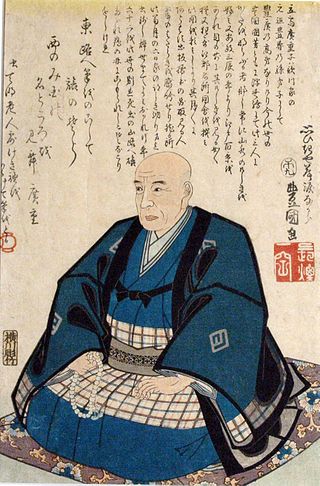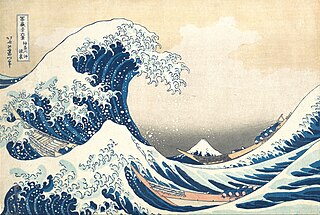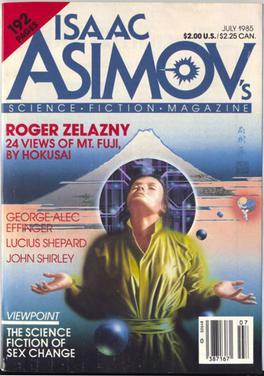
Katsushika Hokusai, known simply as Hokusai, was a Japanese ukiyo-e artist of the Edo period, active as a painter and printmaker. He is best known for the woodblock print series Thirty-Six Views of Mount Fuji, which includes the iconic print The Great Wave off Kanagawa. Hokusai was instrumental in developing ukiyo-e from a style of portraiture largely focused on courtesans and actors into a much broader style of art that focused on landscapes, plants, and animals. His works are thought to have had a significant influence on Vincent van Gogh and Claude Monet during the wave of Japonisme that spread across Europe in the late 19th century.

Shinano Province or Shinshū (信州) is an old province of Japan that is now Nagano Prefecture.

Lake Suwa is a lake in the Kiso Mountains, in the central region of Nagano Prefecture, Japan. The lake is populated by 117,643 people

Utagawa Hiroshige, born Andō Tokutarō, was a Japanese ukiyo-e artist, considered the last great master of that tradition.

Thirty-six Views of Mount Fuji is the title of two series of woodblock prints by Japanese ukiyo-e artist Hiroshige, depicting Mount Fuji in differing seasons and weather conditions from a variety of different places and distances. The 1852 series, published by Sanoya Kihei, are in landscape orientation using the chūban format, while the 1858 series are in the portrait ōban format and were published by Tsutaya Kichizō. The same subject had previously been dealt with by Hokusai in two of his own series, Thirty-six Views of Mount Fuji, produced from c. 1830 to 1832, and One Hundred Views of Mount Fuji, published in three volumes from 1834 to 1849.

Suwa Grand Shrine, historically also known as Suwa Shrine or Suwa Daimyōjin (諏訪大明神), is a group of Shinto shrines in Nagano Prefecture, Japan. The shrine complex is the ichinomiya of former Shinano Province and is considered to be one of the oldest shrines in existence, being implied by the Nihon Shoki to already stand in the late 7th century.
Thirty-six Views of Mount Fuji is a series of woodblock prints by Hokusai.

Thirty-six Views of Mount Fuji is a series of landscape prints by the Japanese ukiyo-e artist Hokusai (1760–1849). The series depicts Mount Fuji from different locations and in various seasons and weather conditions. The immediate success of the publication led to another ten prints being added to the series.

The Great Wave off Kanagawa is a woodblock print by Japanese ukiyo-e artist Hokusai, created in late 1831 during the Edo period of Japanese history. The print depicts three boats moving through a storm-tossed sea, with a large, cresting wave forming a spiral in the centre and Mount Fuji visible in the background.

24 Views of Mt. Fuji, by Hokusai is a science fiction novella by American writer Roger Zelazny, originally published in the July 1985 issue of the Isaac Asimov's Science Fiction Magazine. It won the Hugo Award for Best Novella in 1986 and was also nominated for the Nebula Award for Best Novella in 1985.

The term aizuri-e usually refers to Japanese woodblock prints that are printed entirely or predominantly in blue. When a second color is used, it is usually red. Even if only a single type of blue ink was used, variations in lightness and darkness (value) could be achieved by superimposing multiple printings of parts of the design or by the application of a gradation of ink to the wooden printing block (bokashi).

The Eight Views of Xiaoxiang are scenes of the Xiaoxiang region, in what is now modern Hunan Province, China, that were the subject of the poems and depicted in well-known drawings and paintings from the time of the Song Dynasty. The Eight Views of Xiaoxiang can refer either to various sets of paintings which have been done on this theme, the various verse series on the same theme, or to combinations of both. The Xiaoxiang theme is part of a long poetic and artistic legacy.

The Eight Views of Ōmi are traditional scenic views of Ōmi Province which is now Shiga Prefecture in Japan.

Fine Wind, Clear Morning, also known as Red Fuji, is a woodblock print by Japanese artist Hokusai (1760–1849), part of his Thirty-six Views of Mount Fuji series, dating from c. 1830 to 1832. The work has been described as "one of the simplest and at the same time one of the most outstanding of all Japanese prints".

A Tour of the Waterfalls of the Provinces is a series of landscape woodblock prints by the Japanese ukiyo-e artist Hokusai.

Nishimuraya Yohachi was one of the leading publishers of woodblock prints in late 18th-century Japan. He founded the Nishimuraya Yohachi publishing house, also known as Nishiyo (西与), which operated in Nihonbashi's Bakurochō Nichōme under the shop name Eijudō. The firm's exact dates are unclear, but many art historians date its activity to between c. 1751 and 1860.

Sundai, Edo is a woodblock print by the Japanese ukiyo-e artist Hokusai. It was produced as the fifth print in the series Thirty-six Views of Mount Fuji from c. 1830 to 1832 in the late Edo period.

Kajikazawa in Kai Province is a woodblock print by the Japanese ukiyo-e artist Hokusai.

Thunderstorm Beneath the Summit, also known as Rainstorm Beneath the Summit, or sometimes Black Fuji is a woodcut print by the Japanese ukiyo-e master Hokusai (1760–1849). It is one of the most famous prints from his celebrated Thirty-six Views of Mount Fuji series, published c. 1830–1832.

One Hundred Views of Mount Fuji is a series of three illustrated books by Japanese ukiyo-e artist Hokusai. It is considered one of Japan's most exceptional illustrated books (e-hon), and alongside the Hokusai Manga, the most influential in the West. The first two volumes were published in 1834 and 1835, shortly after completion of his seminal Thirty-six Views of Mount Fuji, with a third released in the late 1840s.



















